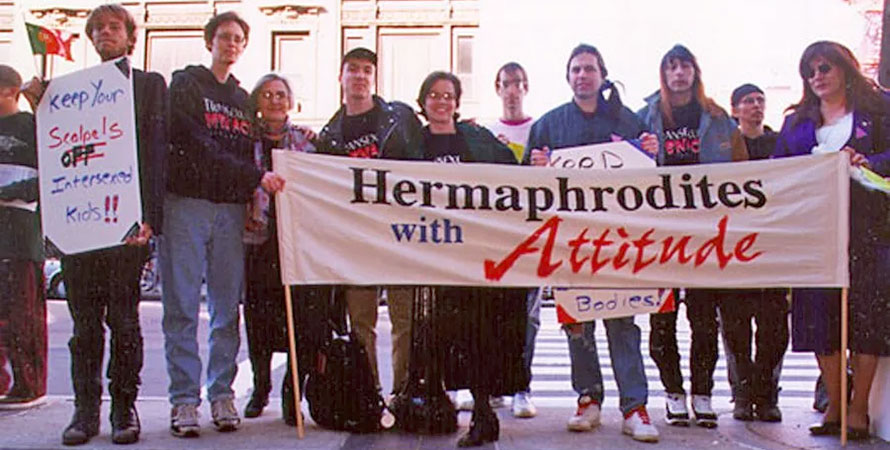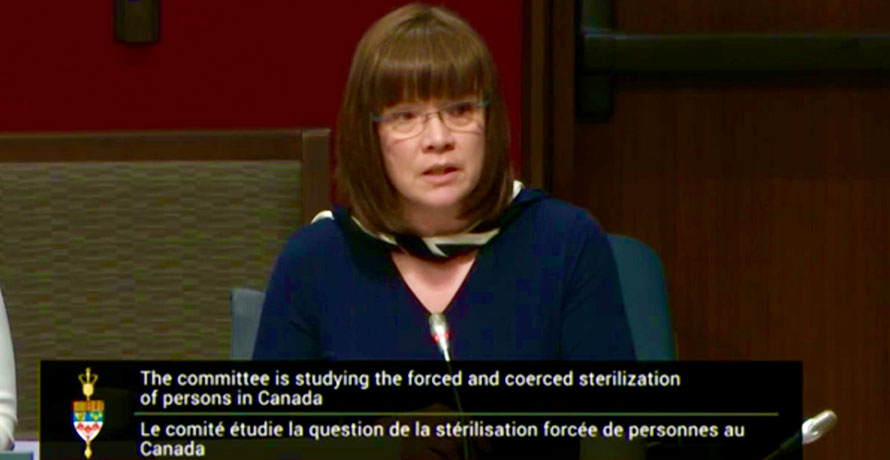We use cookies on this site to enhance your experience.
By selecting “Accept” and continuing to use this website, you consent to the use of cookies.
Search for academic programs, residence, tours and events and more.
Oct. 20, 2025
Print | PDFAs part of a first-of-its kind needs assessment for intersexualized adults in Canada, Wilfrid Laurier University Professor Morgan Holmes interviewed eight individuals about their lives and experiences with the medical system.
“What I heard over and over again was that intersex people are not dismayed about being different; they feel hurt that adults thought they were unlovable,” says Holmes, a professor of Anthropology. “That’s the harm. All of this machination to create cosmetically pleasing bodies and ‘normal’ sexualities teaches kids – and later adults – that they are not viable as human beings. That’s a big burden for people to carry to make their parents happy about what they look like.”
Through academics and activism, Holmes has been at the forefront of the intersex rights movement since the 1990s. She was recently honoured with a King Charles III Coronation Medal for her significant contribution to Canada.

Holmes (centre) protesting the American Academy of Pediatrics' annual convention in Boston in 1996.
By definition, “intersex” refers to a person whose chromosomal, hormonal or anatomical sex characteristics fall outside the conventional classifications of male or female. There are more than 40 different ways that a body may exhibit intersex traits. Physicians may identify intersexuality at birth and decide that the infant requires surgical correction, while some people may be diagnosed as intersex during puberty or later in life.
Holmes advocates for a fundamental shift in how intersexuality is understood, rejecting the medical framework that leads to diagnoses of disorders of sexual development.
“There are certain biological facts unique to intersex, but those facts must then have a particular medical or pathologized meaning imposed upon them,” Holmes writes in her report. “It treats the body of the child or infant as the problem, while our human rights response seeks to position medical authority as the problem.”
Holmes completed the needs assessment while working as a scholar in residence at Egale, Canada’s leading organization for 2SLGBTQI people and issues. Her colleagues at Egale nominated her for the King Charles III Coronation Medal, for which Holmes is deeply grateful. She also expresses gratitude to the study participants for their “fortitude and bravery.”
In this Q&A, Holmes reflects on her research, advocacy and notable contributions.
What are some common misconceptions that persist about intersexuality?
Intersex is regarded as a unique sex and it isn't. It’s not a third category. People can be any gender underneath an intersex umbrella. Most intersex people identify with their sex assigned at birth.
People should also know that intersex is not the same as a trans identity. They are different experiences. But there is considerable overlap because sometimes people were assigned a sex at birth that didn't correspond with the way that their bodies ended up maturing. They then struggle to return to what their biological sex is in the chromosome and hormonal sense while living in an anatomical body that was altered so that it will never correspond.
"Intersex people are not dismayed about being different; they feel hurt that adults thought they were unlovable."
You spoke to eight intersexualized Canadians for your report, Restoring Epistemic Justice to a Dismissed Population. What were some of the common harms the participants shared?
We spoke a lot about what people need from the healthcare system and aren’t getting, or even what medicine is making much worse for them. They shared really inappropriate interference from their physicians, like someone who went in to have their cardiovascular health assessed and was asked if the doctor could “have a peek.”
From a parenting perspective, there are situations where doctors obfuscate their child’s medical issues and exploit the parents’ fears. Children are whisked away to be operated on without appropriate knowledge or consent. We see kids who are diagnosed with a hernia, but they don’t have a hernia and instead lose their gonads.
The removal of reproductive organs from intersex children is a massive point of contention for survivors. Their capacity to have children was taken away from them.
The report suggests that intersexuality is perceived to be rare, preventing society from seriously addressing associated issues. What sort of data do we have available?
Through working with organizations like Health Canada, the Public Health Agency of Canada, Statistics Canada and the Ontario Health Insurance Plan, I learned that we don’t have accurate numbers recording what is happening in our healthcare system. There aren’t billing codes for procedures intersex people undergo, such as clitorectomies, but that doesn't mean they aren’t happening. Surgeons process them as something else.
We did get five years’ worth of data from Quebec, where they keep better records, and we can extrapolate that there are several thousand people being operated on across Canada every five years. However, I don't think that our moral clarity comes from population numbers. We don't determine whether assault or murder matter based on how many people are assaulted or murdered. One assault or one murder is a crime. So I don't care how many there are. To me, that's a moot point.

Holmes testifying at the Senate hearings on forced sterilization in 2019.
In 2017, you worked with Canada’s Department of Justice to re-evaluate gender markers on government documents. How did that play out?
The government’s well-meaning gesture was to suggest marking ‘X’ as the gender on birth registrations for babies who are diagnosed as intersex. I told them that wasn’t going to help because when that child grows up and presents as either male or female, if they have paperwork that says ‘we don’t know’ and try to cross the border, some prurient person is going to pull them into a room and feel entitled to satisfy their curiosity. We have found that to be a real threat for intersex people.
While interviewing parents, we also found that marking their child with an X was unacceptable. Instead of allowing more time for the child to find out who they are and how they want to present to the world, the X would rush the parents to do what they needed to do to change it to an ‘M’ or ‘F.’ So the X would actually do more damage.
In the end, it was decided that people can choose to have an X, but we do not impose it on infants who can’t make a choice. That was a good outcome for us, but there is lots of work still to be done.
You are working with Egale to challenge the constitutionality of exemptions in Canada’s Criminal Code that permit ‘normalizing’ aesthetic surgeries on intersex infants and children, prior to these individuals being old enough to consent to such surgeries. Tell us about that.
We launched a Charter challenge in 2021 to remove a paragraph in the criminal code regarding genital mutilation. If there is a cosmetic difference that is unacceptable in the culture and will imperil this person because nobody is going to find them attractive, then you get to refashion that body any way that you like, and there is no recourse for that person later in their life.
The Ontario Superior Court of Justice accepted our filing, meaning that they found the case to be legitimate, but our challenge is still just sitting there. The wheels of justice move slowly. Which is unfortunate because in 2012 we conducted interviews in Stockholm with the European Union’s special rapporteur and they went back to the Hague and said, ‘These procedures qualify as medical torture.’ But, so far, it is still perfectly legal in Canada to interfere with the appearance of a non-consenting person in the interests of creating a heteronormative body.
"We need to listen to the people who are saying, ‘This is harmful. This interferes with my identity formation. This interferes with my health.’ That is more important than whether clinicians think they did a good job."
The intention of your report was to restore justice to intersexualized people. What recommendations came out of your research?
I think that people need to stop giving primary legitimacy to the clinicians on this topic. I think we need to listen to the people who have lived experience.
In a future sense, the category of ‘intersex’ just wouldn't exist. We would just be people. Some people would be tall and some people would be short, and some people would have genitals that look this way and some that look that way. We would just embrace the plurality of human beings.
For now, we need to listen to the people who are saying, ‘This is harmful. This interferes with my identity formation. This interferes with my health.’ That is more important than whether clinicians think they did a good job.
What does winning the King Charles III Coronation Medal mean to you?
The medal is important to me not as recognition, but as an opportunity to talk about what has happened to thousands and thousands of other people in our country.
It also allows me to say that there are people younger than I who are going to carry this forward and, I think, bring it to resolution. Nothing happens thanks to a single individual in a vacuum. I guess I get the medal for going first, but there is now a peer-driven organization called Intersex Canada that will carry some of this advocacy forward. And there are critical intersex studies happening all over the world.
I had a role in this movement for sure, but I want to leave it behind. I want to work on totally different things, and finally it’s possible to do that.